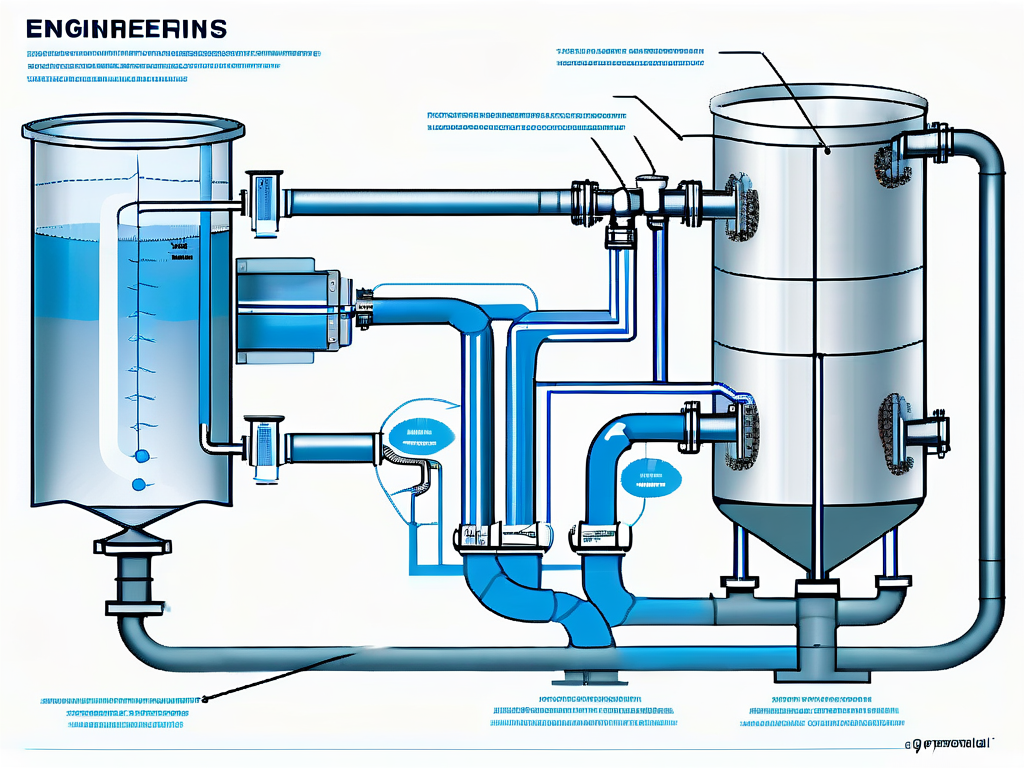
Tertiary Clarifier: Wastewater Treatment Explained
In the realm of wastewater treatment, the term "Tertiary Clarifier" refers to a crucial stage in the process where the water, after undergoing primary and secondary treatment, is further treated to remove any remaining suspended solids and organic matter. This final clarification stage is essential in ensuring the treated water meets environmental discharge standards, thus playing a vital role in safeguarding our water resources and environment.
The tertiary clarifier, also known as the final clarifier, operates on the principle of sedimentation, where gravity is used to separate solids from the water. This process is facilitated by the use of clarifiers - large, circular tanks that allow the solids to settle at the bottom, while the clarified water overflows from the top. The settled solids, known as sludge, are then removed for further treatment or disposal.
Design and Operation of a Tertiary Clarifier
The design of a tertiary clarifier is a complex task that requires a deep understanding of the characteristics of the wastewater, the desired level of treatment, and the specific environmental conditions at the site. The size, shape, and configuration of the clarifier are all critical factors that can significantly impact its performance.

The operation of a tertiary clarifier involves a delicate balance of various parameters, including flow rate, retention time, and sludge removal. The goal is to maximize the removal of solids while minimizing the use of energy and chemicals. This requires constant monitoring and adjustment to ensure optimal performance.
Components of a Tertiary Clarifier
A tertiary clarifier is composed of several key components, each playing a unique role in the clarification process. These include the inlet and outlet structures, the settling zone, the sludge collection system, and the scum removal system.
The inlet structure is designed to distribute the incoming wastewater evenly across the entire surface area of the clarifier. The outlet structure, on the other hand, is designed to collect the clarified water without disturbing the settling process. The settling zone is where the actual sedimentation takes place, with the solids settling at the bottom and the clarified water rising to the top.
Types of Tertiary Clarifiers
There are several types of tertiary clarifiers, each with its own unique design and operating principles. These include the conventional clarifier, the high-rate clarifier, the lamella clarifier, and the dissolved air flotation (DAF) clarifier.
The conventional clarifier is the most common type, featuring a large, circular tank with a slow-moving rake mechanism to collect the settled sludge. The high-rate clarifier, on the other hand, uses a faster settling process and a more compact design, making it suitable for applications with space constraints. The lamella clarifier uses a series of inclined plates to increase the settling area, while the DAF clarifier uses air bubbles to float the solids to the surface for removal.
Role of Tertiary Clarifiers in Wastewater Treatment
Tertiary clarifiers play a vital role in the wastewater treatment process, serving as the final barrier to remove any remaining solids and organic matter before the treated water is discharged into the environment. By doing so, they help to ensure that the treated water meets the required environmental standards, thus protecting our water resources and ecosystems.
Moreover, the sludge collected from the tertiary clarifiers is often rich in nutrients, making it a valuable resource for applications such as agriculture and energy production. Thus, tertiary clarifiers not only help to clean our water, but also contribute to resource recovery and sustainability.
Environmental Impact of Tertiary Clarifiers
The environmental impact of tertiary clarifiers is largely positive, as they help to prevent the discharge of harmful pollutants into our water bodies. By removing the remaining solids and organic matter, they reduce the risk of eutrophication, a process where excess nutrients in the water lead to harmful algal blooms and oxygen depletion, which can have devastating effects on aquatic life.
However, the operation of tertiary clarifiers also requires energy and chemicals, which can have their own environmental impacts. Therefore, it is important to optimize the design and operation of the clarifiers to minimize these impacts while maximizing their treatment performance.
Regulatory Requirements for Tertiary Clarifiers
The operation of tertiary clarifiers is subject to various regulatory requirements, which are designed to ensure the protection of our water resources and the health and safety of the public. These requirements typically specify the maximum allowable concentrations of various pollutants in the treated water, as well as the methods and frequency of monitoring and reporting.
Non-compliance with these requirements can result in severe penalties, including fines and legal action. Therefore, it is crucial for wastewater treatment plants to have a thorough understanding of these requirements and to implement robust systems for compliance management.
Challenges and Future Directions in Tertiary Clarification
Despite the crucial role of tertiary clarifiers in wastewater treatment, there are several challenges that need to be addressed to further improve their performance and sustainability. These include the need for more efficient energy use, the reduction of chemical usage, and the management of sludge disposal.

Future directions in tertiary clarification may include the development of new technologies and processes that can enhance the removal of solids, reduce energy and chemical usage, and facilitate the recovery of valuable resources from the sludge. Research and innovation in this area will be key to meeting the increasing demands for wastewater treatment in a sustainable and cost-effective manner.
Emerging Technologies in Tertiary Clarification
Several emerging technologies hold promise for improving the performance and sustainability of tertiary clarifiers. These include membrane technologies, which can provide a physical barrier to remove even the smallest particles, and advanced oxidation processes, which can degrade organic matter at the molecular level.
Another promising technology is the use of biofilms, which are communities of microorganisms that can degrade organic matter and capture solids. These technologies, while still in the early stages of development, could revolutionize the field of tertiary clarification in the coming years.
Conclusion
In conclusion, tertiary clarifiers are a critical component of the wastewater treatment process, serving as the final barrier to remove any remaining solids and organic matter before the treated water is discharged into the environment. Their design and operation require a deep understanding of the characteristics of the wastewater, the desired level of treatment, and the specific environmental conditions at the site.
Despite the challenges, the future of tertiary clarification looks promising, with several emerging technologies holding the potential to improve performance and sustainability. As we continue to strive for cleaner water and a healthier environment, the role of tertiary clarifiers in wastewater treatment will only become more important.



